*NURSING > EXAM > MED SURG FINAL EXAM QUESTION BANK (From Exams 1-3 & ATI’s).docx | Already Graded A. (All)
MED SURG FINAL EXAM QUESTION BANK (From Exams 1-3 & ATI’s).docx | Already Graded A.
Document Content and Description Below
MED SURG FINAL EXAM QUESTION BANK (From Exams 1-3 & ATI’s) Exam 1 1. A patient has received atropine before surgery and complains of dry mouth. Which action by the nurse is best? Answer: Tell the ... patient dry mouth is an expected side effect. 2. A patient arrives at the ambulatory surgery center for a scheduled laparoscopy procedure in outpatient surgery. Which information is of most concern to the nurse? Answer: The patient is planning to drive home after surgery. 3. As the nurse prepares a patient the morning of surgery, the patient refuses to remove a wedding ring, saying, "I have never taken it off since the day I was married." Which response by the nurse is best? Answer: Suggest that the patient give the ring to a family member to keep. 4. The outpatient surgery nurse reviews the complete blood cell (CBC) count results for a patient who is scheduled for surgery in a few days. The results are white blood cell (WBC) count 10.2 × 103/µL; hemoglobin 15 g/dL; hematocrit 45%; platelets 150 × 103/µL. Which action should the nurse take? Answer: Continue to prepare the patient for the surgical procedure. 5. A 36-year-old female is admitted for an elective surgical procedure. Which information obtained by the nurse during the preoperative assessment is most important to report to the anesthesiologist before surgery? Answer: The patient's statement that her last menstrual period was 8 weeks ago 6. Which information in the preoperative patient's medication history is most important to communicate to the health care provider? Answer: The patient takes garlic capsules daily. 7. A patient who takes a diuretic and a β-blocker to control blood pressure is scheduled for breast reconstruction surgery. Which patient information is most important to communicate to the health care provider before surgery? Answer: Serum potassium 3.2 mEq/L 8. Monitored anesthesia care (MAC) is going to be used for a closed, manual reduction of a dislocated shoulder. What does the nurse anticipate? Answer: Starting an IV in the patient’s unaffected arm. 9. While in the holding area, a patient reveals to the nurse that his father had a high fever after surgery. What action by the nurse is a priority? Answer: Alert the anesthesia care provider of the family member’s reaction to surgery 10. The nurse facilitates student clinical experiences in the surgical suite. Which action, if performed by a student, would require the nurse to intervene? Answer: The student wears street clothed in the semi-restricted area. 11. The operating room nurse is providing orientation to a student nurse. Which action would the nurse list as a major responsibility of a scrub nurse? Answer: Keep both hands above the operating table level 12. A patient in surgery receives a neuromuscular blocking agent as an adjunct to general anesthesia. While in the PACU, what assessment finding is most important for the nurse to report? Answer: Weak chest movement 13. Which action in the perioperative patient plan of care can the charge nurse delegate to a surgical technologist? Answer: Pass sterile instruments and supplies to the surgeon and scrub technician 14. When caring for a patient who has received general anesthetic, the circulating nurse notes red, raised wheals on the patient’s arms. Which action should the nurse take? Answer: Notify the ACP 15. The NG tube is removed 2nd day postop, pt is placed on a clear, liquid diet. 4 hrs later the pt complains of sharp, cramping gas pains. What action by the RN is most appropriate? Answer: assist the patient to ambulate 16. On admission of a patient to the postanesthesia care unit (PACU), the blood pressure (BP) is 122/72. Thirty minutes after admission, the BP falls to 114/62, with a pulse of 74 and warm, dry skin. Which action by the nurse is most appropriate? Answer: Continue to take vital signs every 15 minutes. 17. A postop patient has not voided for 8 hrs after surgery…. what action should the nurse take first? Answer: Bladder scan 18. A patient is transferred from the postanesthesia care unit (PACU) to the clinical unit. Which action by the nurse on the clinical unit should be performed first? Answer: Take the patient's vital signs. 19. A postop pt has a nursing dx of ineffective airway clearance. The nurse determines that interventions for this nursing diagnosis have been successful if which is observed? Answer: Patients breath sounds are clear to auscultation 20. In the postanesthesia care unit (PACU), a patient's vital signs are blood pressure 116/72, pulse 74, respirations 12, and SpO2 91%. The patient is sleepy but awakens easily. Which action should the nurse take first? Answer: Encourage the patient to take deep breaths. 21. Which action could the PACU nurse delegate to an UAP? Answer: Help with transfer onto a stretcher 22. An older pt is being dc from the ambulatory surgical unit following L eye surgery. The pt tells the nurse, “I don’t know if I can take care of myself once I’m home”. Which action by the nurse is most appropriate? Answer: discuss specific concerns regarding self-care 23. A patient is admitted with possible botulism poisoning after eating home-canned green beans. Which intervention ordered would the nurse question? Answer: Encourage oral fluids to 3L/day 24. A 22-year-old patient who sustained a T2 spinal cord injury 10 days ago tells the nurse "i want to be transferred to a hospital where the nurses know what they are doing"… Answer: Request patient to take part in their care 25. The nurse will explain to the patient who has a T2 spinal cord transection injury that… Answer: function of both arms should be retained 26. A 27-year-old patient is hospitalized with new onset of Guillain-Barré syndrome. The most essential assessment for the nurse to carry out is? Answer: observing respiratory rate and effort. 27. A construction worker arrives at an urgent care center with a deep puncture wound after an old nail penetrated his boot.. The patient reports having had a tetanus booster 6 years ago. The nurse will anticipate? Answer: administration of the tetanus-diphtheria (Td) booster. 28. Which assessment data for a patient who has GBS will require the nurses most immediate action? Answer: The patient is continuously drooling saliva 29. A 35 yr old pt who has had a spinal cord injury returned home following rehab. The home care RN notes the spouse is performing many of the activities the pt has been managing unassisted in rehab… Answer: develop a plan to increase pt independence in consult with pt and spouse 30. Which nursing action will the home health nurse include in the plan of care for a patient with paraplegia at the T4 level in order to prevent autonomic dysreflexia? Answer: Assist in planning a prescribed bowel program. 31. When giving home care instructions to a patient who has comminuted L forearm fractures ana long-arm cast, which info should the nurse include? Answer: Call the health care provider for numbness of the hand 32. Which statement by the pt indicates a good understanding of the nurse’s teaching about a new short-arm synthetic cast? Answer: “I will apply an ice pack to the cast over the fracture site off and on for 24 hrs” 33. Which dc instruction will the ED nurse include for a pt w/ a sprained ankle? Answer: use pillows to elevate the ankle above the heart 34. A pt w/ a complex pelvic fracture from a MVC is on bed rest. Which nursing assessment finding indicates a potential complication? Answer: Abdomen is distended and bowel sounds are absent 35. How often should pin site care be performed? Daily with sterile cotton tipped applicator. Books says to use chlorhexidine not hydrogen peroxide. 36. A pt who is to have NWB on the R leg is learning to walk w/ crutches. Which observation by the nurse indicates the pt can ambulate independently? Answer: The pt advances the right leg and both crutches together and then advances the left leg 37. A pt is being dc in 3 days after hip arthroplasty using the posterior approach. Which action requires intervention? Answer: The pt leans over to pull on shoes and socks 38. Which info will the nurse teach seniors at a community recreation center about ways to prevent fractures? Answer: Buy shoes that provide good support and are comfortable 39. When caring for a preoperative patient on the day of surgery, which actions included in the plan of care can the nurse delegate to unlicensed assistive personnel (UAP)? (Select all that apply.) Answers: Obtain and document baseline vital signs, remove nail polish and apply pulse oximeter, Transport the patient by stretcher to the operating room. 40. Which actions will the nurse include in the surgical time-out procedure before surgery? Answer: Verify pt ID band number, ask pt to state procedure, pt state name and DOB Exam 2 1. A pts cap BG level is 120 mg/dL 6 hrs after the nurse initiated a parenteral nutrition infusion. The appropriate action by the nurse is to a. Recheck BG 4-6 hrs later 2. After abdominal surgery, a pt w/ protein calorie malnutrition that is receiving PN; what is the best indicator of adequate nutrition? a. Surgical incision is healing normally 3. When caring for a pt with a soft, silicone NG tube in place for tube feeding the nurse will a. Flush the tubing after checking for residual volume 4. A 76 yr old woman w/ a BMI of 17 kg/m2 and a low serum albumin level is being admitted by the nurse. Which assessment finding will the nurse expect to find? a. Pitting edema 5. A healthy adult woman who weighs 145 lb asks the clinic nurse about the minimum daily requirement for protein. How many grams of protein will the nurse recommend? a. 53 6. Which menu choice best indicates that the pt is implementing the nurses suggestion to choose high-calorie, high-protein food? a. Fried chicken with potatoes and gravy 7. The nurse will be teaching self-management to pts after gastric bypass surgery. Which info will the nurse plan to include? a. Drink fluids between meals but not with meals 8. A pt is being admitted for bariatric surgery. Which nursing action can the nurse delegate to UAP? a. Assist with IV insertion by holding adipose tissue out of the way 9. After the nurse teaches a pt about the recommended amounts of foods from animal and plant sources, which menu selections indicate that the initial instructions about diet have been understood? a. 3 oz of roasted pork, a cup of corn, and a cup of carrot sticks 10. Which item should the nurse offer to the pt who is to restart oral intake after being NPO due to nausea and vomiting? a. Dish of lemon gelatin 11. Which info will the nurse include when teaching adults to decrease the risk of cancers of the tongue and buccal mucosa? a. Avoid use of cigarettes and smokeless tobacco 12. Which info will the nurse include when teaching a pt with peptic ulcer disease about the effect of zantac? a. Ranitidine decreases gastric acid secretion 13. A pt vomiting blood-streaked fluid is admitted to the hospital with acute gastritis. To determine possible risk factors for gastritis, the nurse will ask the pt about a. Use of NSAIDs 14. The nurse explaining esomeprazole (Nexium) to a patient with recurring heartburn describes that the medication a. Treats GERD by decreasing stomach acid production 15. A pt who has GERD is experiencing increasing discomfort. Which pt statement to the nurse indicates that additional teaching about GERD is needed? a. “I eat small meals during the day and have a bedtime snack” 16. The health care provider prescribes antacids and sucralfate (Carafate) for treatment of a pts peptic ulcer. The nurse will teach the patient to take a. Antacids after meals and sucralfate 30 minutes before meals 17. Which info will the nurse include for a pt that is newly diagnosed with GERD? a. “Keep the HOB elevated on blocks” 18. A pt has peptic ulcer disease that has been associated with Helicobacter pylori. About which meds will the nurse plan to teach the patient? a. Amoxicillin (Amoxil), clarithromycin (Biaxin), and omeprazole (Prilosec) 19. The nurse evaluates that admin of Hep B vaccine to a healthy pt has been effective when the pts blood specimen reveals a. Anti-HBs 20. Which action should the nurse take to evaluate treatment effectiveness for a pt who has hepatic encephalopathy? a. Ask the pt to extend both arms forward 21. Which info given by a 70 yr old pt during a health history indicates to the nurse that the pt should be screened for hep C? a. The pt used IV drugs about 20 yrs ago 22. Which finding indicates to the nurse that lactulose is effective for an older adult who has advanced cirrhosis? a. The pt is alert and oriented 23. A pt is transferred from the recovery room to a surgical unit after a transverse colostomy. The nurse observes the stoma to be deep pink with edema and a small amount of sanguineous drainage. The nurse should a. Document stoma assessment findings 24. The nurse preparing for the annual physical exam of a 50 yr old man will plan to teach the patient about a. Colonoscopy 25. A pt with a new ileostomy asks how much drainage to expect. The nurse explains that after the bowel adjusts to the ileostomy, the usual drainage will be about cups daily a. 2 26. A pt with diverticulosis has a large bowel obstruction. The nurse will monitor for a. Abdominal distention 27. A pt being admitted with an acute exacerbation of ulcerative colitis reports crampy abdominal pain and passing 15 or more bloody stools a day. The nurse will plan to a. Discontinue the pts oral food intake 28. A pt has a new diagnosis of Crohn’s disease after having frequent diarrhea and a weight loss of 10 lb over 2 months. The nurse will plan to teach about a. Medication use 29. Which assessment should the nurse perform first for a pt who just vomited bright red blood? a. Taking the BP and the pulse 30. After bariatric surgery, a pt who is being discharged tells the nurse “I prefer to be independent. I am not interested in any support groups” which reponse by the nurse is best? a. “Tell me what types of resources you think you might use after surgery” 31. 0.25 mL dilaudid 32. 85 mL/hr RBC 33. In what quadrant is the liver located? a. Left upper and right upper 34. Picture a. 35. 0.8 mL enoxaparin 36. 2 tablets digoxin 37. 20 mcg sodium 38. 2 tablets aspirin Exam 3 A patient with a family history of cystic fibrosis (CF) asks for information about genetic testing. Which response by the nurse is most appropriate? a. Refer the patient to a qualified genetic counselor. When caring for a young adult patient who has abnormalities in the cytochrome P450 (CYP 450) gene, which action will the nurse include in the patient’s plan of care? a. Teach that some medications may not work effectively. A patient tells the nurse, “I would like to use a home genetic test to see if I will develop breast cancer.” Which is the nurse’s best initial response? c. “Are you concerned about developing breast cancer?” The nurse in the outpatient clinic has obtained health histories for these new patients. Which patient may need referral for genetic testing? c. A 30-yr-old patient who has a sibling with newly diagnosed polycystic kidney disease The nurse provides discharge instructions to a patient who has an immune deficiency involving the T lymphocytes. Which health screening should the nurse include in the teaching plan for this patient? b. Screening for malignancies Which example should the nurse use to explain an infant’s “passive immunity” to a new mother? b. Breastfeeding A patient is being evaluated for possible atopic dermatitis. The nurse expects elevation of which laboratory value? a. IgE An older adult patient who is having an annual check-up tells the nurse, “I feel fine, and I don’t want to pay for all these unnecessary cancer screening tests!” Which information should the nurse plan to teach this patient? a. Consequences of aging on cell-mediated immunity The nurse taking a health history learns that the patient, who has worked in rubber tire manufacturing, has allergic rhinitis and multiple food allergies. Which action by the nurse is correct? b. Document the patient’s history and teach about clinical manifestations of a type I latex allergy. Which statement by a patient would alert the nurse to a risk for decreased immune function? b. “I had my spleen removed after a car accident.” Ten days after receiving a bone marrow transplant, a patient develops a skin rash. What would the nurse suspect is the cause of the rash? a. The donor T cells are attacking the patient’s skin cells. A patient seeks care in the emergency department after sharing needles for heroin injection with a friend who has hepatitis B. To provide immediate protection from infection, what medication will the nurse expect to administer? b. Gamma globulin The nurse is advising a clinic patient who was exposed a week ago to human immunodeficiency virus (HIV) through unprotected sexual intercourse. The patient’s antigen and antibody test has just been reported as negative for HIV. What instructions should the nurse give to this patient? a. “You will need to be retested in 2 weeks.” A patient informed of a positive rapid antibody test result for human immunodeficiency virus (HIV) is anxious and does not appear to hear what the nurse is saying. What action by the nurse is most important at this time? c. Remind the patient about the need to return for retesting to verify the results. A patient who is diagnosed with acquired immunodeficiency syndrome (AIDS) tells the nurse, “I feel obsessed with morbid thoughts about dying.” Which response by the nurse is appropriate? c. “Can you tell me more about the thoughts that you are having?” Which patient exposure by the nurse is most likely to require postexposure prophylaxis when the patient’s human immunodeficiency virus (HIV) status is unknown? c. Needle stick with a needle and syringe used for a venipuncture A patient who uses injectable illegal drugs asks the nurse about preventing acquired immunodeficiency syndrome (AIDS). Which response by the nurse is best? c. “Consider participating in a needle-exchange program.” The nurse prepares to administer the following medications to a hospitalized patient with human immunodeficiency (HIV). Which medication is most important to administer at the scheduled time? c. Oral saquinavir (Invirase) To evaluate the effectiveness of antiretroviral therapy (ART), which laboratory test result will the nurse review? a. Viral load testing The registered nurse (RN) caring for an HIV-positive patient admitted with tuberculosis can delegate which action to unlicensed assistive personnel (UAP)? b. Stock the patient’s room with the necessary personal protective equipment. A patient who is scheduled for a breast biopsy asks the nurse the difference between a benign tumor and a malignant tumor. Which answer by the nurse is correct? c. “Malignant tumors may spread to other tissues or organs.” The nurse is caring for a patient who smokes two packs/day. Which action by the nurse could help reduce the patient’s risk of lung cancer? d. Discuss risks associated with cigarette smoking during each patient encounter. The nurse teaches a patient who is scheduled for a prostate needle biopsy about the procedure. Which statement, if made by the patient, indicates that teaching was effective? c. “The biopsy will help decide the treatment for my enlarged prostate.” The nurse is caring for a patient with colon cancer who is scheduled for external radiation therapy to the abdomen. Which information obtained by the nurse would indicate a need for patient teaching? b. The patient swims several days each week. A patient with metastatic cancer of the colon experiences severe vomiting after each administration of chemotherapy. Which action, if taken by the nurse, is appropriate? c. Administer prescribed antiemetics 1 hour before the treatments. The nurse administers an IV vesicant chemotherapeutic agent to a patient. Which action is most important for the nurse to take? b. Stop the infusion if swelling is observed at the site. A chemotherapy drug that causes alopecia is prescribed for a patient. Which action should the nurse take to support the patient’s self-esteem? a. Encourage the patient to purchase a wig or hat to wear when hair loss begins. A patient who has a small cell carcinoma of the lung develops syndrome of inappropriate antidiuretic hormone (SIADH). The nurse should notify the health care provider about which assessment finding? b. Serum sodium level of 120 mg/dL IV potassium chloride (KCl) 60 mEq is prescribed for treatment of a patient with severe hypokalemia. Which action should the nurse take? b. Infuse the KCl at a rate of 10 mEq/hour. A patient who was involved in a motor vehicle crash has had a tracheostomy placed to allow for continued mechanical ventilation. How should the nurse interpret the following arterial blood gas results: pH 7.48, PaO2 85 mm Hg, PaCO2 32 mm Hg, and HCO3 25 mEq/L? d. Respiratory alkalosis White on Right, Snow over trees, smoke over fire, chocolate warms the heart Chapter 29: Assessment of Hematologic System 1. The nurse is caring for a patient who is being discharged after an emergency splenectomy following a motor vehicle crash. Which instructions should the nurse include in the discharge teaching? d. Wash hands and avoid persons who are ill. 2. The nurse assesses a patient who has numerous petechiae on both arms. Which question should the nurse ask the patient? c. “Do you take medication containing salicylates?” 3. A nurse reviews the laboratory data for an older patient. The nurse would be most concerned about which finding? d. White blood cell (WBC) count of 2800/µL 4. A patient with pancytopenia has a bone marrow aspiration from the left posterior iliac crest. Which action would be important for the nurse to take after the procedure? b. Have the patient lie on the left side for 1 hour. 5. The nurse assesses a patient with pernicious anemia. Which assessment finding would the nurse expect? c. Numbness of the extremities 6. A patient’s complete blood count (CBC) shows a hemoglobin of 19 g/dL and a hematocrit of 54%. Which question should the nurse ask to determine possible causes of this finding? b. “Do you have any history of lung disease?” 7. The nurse is reviewing laboratory results and notes a patient’s activated partial thromboplastin time (aPTT) level of 28 seconds. The nurse should notify the health care provider in anticipation of adjusting which medication? b. Heparin 8. The nurse notes pallor of the skin and nail beds in a newly admitted patient. The nurse should ensure that which laboratory test has been ordered? c. Hemoglobin level 9. The nurse examines the lymph nodes of a patient during a physical assessment. Which assessment finding would be of most concern to the nurse? a. A 2-cm nontender supraclavicular node 10. A patient who had a total hip replacement had an intraoperative hemorrhage 14 hours ago. Which laboratory test result would the nurse expect? c. Elevated reticulocyte count 11. The complete blood count (CBC) indicates that a patient is thrombocytopenic. Which action should the nurse include in the plan of care? a. Avoid intramuscular injections. 12. The health care provider’s progress note for a patient states that the complete blood count (CBC) shows a “shift to the left.” Which assessment finding will the nurse expect? c. Elevated temperature 13. The health care provider orders a liver and spleen scan for a patient who has been in a motor vehicle crash. Which action should the nurse take before this procedure? d. Assist the patient to a flat position. 14. A patient with pancytopenia of unknown origin is scheduled for the following diagnostic tests. The nurse will provide a consent form to sign for which test? a. Bone marrow biopsy 15. The nurse reviews the laboratory test results of a patient admitted with abdominal pain. Which information will be most important for the nurse to communicate to the health care provider? d. White blood cell (WBC) count 15,500/µL 16. Which information shown in the table below about a patient who has just arrived in the emergency department is most urgent for the nurse to communicate to the health care provider? Assessment Complete Blood Count Patient History · BP 110/68 · Pulse 98 beats/min · Brisk capillary refill · Multiple ecchymoses on arms · Hgb 10.6 g/dL · Hct 30% · WBC 5100/µL · Platelets 19,500/µL · Occasional aspirin use · Abdominal pain x 1 week · Large, dark stool this morning b. Platelet count Chapter 30: Hematologic Problems 1. A 62-year old man with chronic anemia is experiencing increased fatigue and occasional palpitations at rest. The nurse would expect the patient’s laboratory test findings to include d. a hemoglobin (Hgb) of 8.6 g/dL (86 g/L). 2. Which menu choice indicates that the patient understands the nurse’s teaching about recommended dietary choices for iron-deficiency anemia? a. Omelet and whole wheat toast 3. A patient who is receiving methotrexate for severe rheumatoid arthritis develops a megaloblastic anemia. The nurse will anticipate teaching the patient about increasing oral intake of b. folic acid. 4. A 52-yr-old patient has a new diagnosis of pernicious anemia. The nurse determines that the patient understands the teaching about the disorder when the patient states, c. “I could choose nasal spray rather than injections of vitamin B12.” 5. An appropriate nursing intervention for a hospitalized patient with severe hemolytic anemia is to b. alternate periods of rest and activity. 6. Which patient statement to the nurse indicates a need for additional instruction about taking oral ferrous sulfate? a. “I will call my health care provider if my stools turn black.” 7. Which collaborative problem will the nurse include in a care plan for a patient admitted to the hospital with idiopathic aplastic anemia? b. Potential complication: infection 8. It is important for the nurse providing care for a patient with sickle cell crisis to b. evaluate the effectiveness of opioid analgesics. 9. Which statement by a patient indicates good understanding of the nurse’s teaching about prevention of sickle cell crisis? d. “Risk for a crisis is decreased by having an annual influenza vaccination.” 10. Which instruction will the nurse plan to include in discharge teaching for a patient admitted with a sickle cell crisis? c. Avoid exposure to crowds when possible. 11. The nurse notes scleral jaundice in a patient being admitted with hemolytic anemia. The nurse will plan to check the laboratory results for the b. bilirubin level. 12. A patient who has been receiving IV heparin infusion and oral warfarin (Coumadin) for a deep vein thrombosis (DVT) is diagnosed with heparin-induced thrombocytopenia (HIT) when the platelet level drops to 110,000/µL. Which action will the nurse include in the plan of care? b. Discontinue the heparin infusion. 13. An expected action by the nurse caring for a patient who has an acute exacerbation of polycythemia vera is to d. monitor fluid intake and output. 14. Which intervention will be included in the nursing care plan for a patient with immune thrombocytopenic purpura? b. Avoid intramuscular (IM) injections. 15. Which laboratory result will the nurse expect to show a decreased value if a patient develops heparin-induced thrombocytopenia (HIT)? d. Activated partial thromboplastin time 16. The nurse is caring for a patient with type A hemophilia being admitted to the hospital with severe pain and swelling in the right knee. The nurse should b. immobilize the knee joint. 17. A young adult who has von Willebrand disease is admitted to the hospital for minor knee surgery. The nurse will review the coagulation survey to check the b. bleeding time. 18. A routine complete blood count for an active older man indicates possible myelodysplastic syndrome. The nurse will plan to teach the patient about b. bone marrow biopsy. 19. Which action will the admitting nurse include in the care plan for a patient who has neutropenia? b. Check temperature every 4 hours. 20. Which laboratory test will the nurse use to determine whether filgrastim (Neupogen) is effective for a patient with acute lymphocytic leukemia who is receiving chemotherapy? d. Absolute neutrophil count 21. A patient who has acute myelogenous leukemia (AML) asks the nurse whether the planned chemotherapy will be worth undergoing. Which response by the nurse is appropriate? b. “The side effects of chemotherapy are difficult, but AML frequently goes into remission with chemotherapy.” 22. A patient who has a history of a transfusion-related acute lung injury (TRALI) is to receive a transfusion of packed red blood cells (PRBCs). Which action by the nurse will decrease the risk for TRALI for this patient? b. Transfuse only leukocyte-reduced PRBCs. 23. A patient who has acute myelogenous leukemia (AML) is considering treatment with a hematopoietic stem cell transplant (HSCT). The best approach for the nurse to assist the patient with a treatment decision is to b. ask whether there are questions or concerns about HSCT. 24. Which action will the nurse include in the plan of care for a patient admitted with multiple myeloma? a. Monitor fluid intake and output. 25. An appropriate nursing intervention for a patient with non-Hodgkin’s lymphoma whose platelet count drops to 18,000/µL during chemotherapy is to a. check all stools for occult blood. 26. A patient who has acute myelogenous leukemia develops an absolute neutrophil count of 850/µL while receiving outpatient chemotherapy. Which action by the outpatient clinic nurse is most appropriate? b. Teach the patient to administer filgrastim (Neupogen) injections. 27. Which assessment finding should the nurse caring for a patient with thrombocytopenia communicate immediately to the health care provider? b. The patient is difficult to arouse. 28. The nurse is planning to administer a transfusion of packed red blood cells (PRBCs) to a patient with blood loss from gastrointestinal hemorrhage. Which action can the nurse delegate to unlicensed assistive personnel (UAP)? b. Obtain the temperature, blood pressure, and pulse before the transfusion. 29. A postoperative patient receiving a transfusion of packed red blood cells develops chills, fever, headache, and anxiety 35 minutes after the transfusion is started. After stopping the transfusion, what action should the nurse take? c. Administer PRN acetaminophen (Tylenol). 30. A patient in the emergency department complains of back pain and difficulty breathing 15 minutes after a transfusion of packed red blood cells is started. The nurse’s first action should be to d. disconnect the transfusion and infuse normal saline. 31. Which patient should the nurse assign as the roommate for a patient who has aplastic anemia? a. A patient with chronic heart failure 32. Which patient requires the most rapid assessment and care by the emergency department nurse? b. The patient with neutropenia who has a temperature of 101.8° F 33. A patient with immune thrombocytopenic purpura (ITP) has an order for a platelet transfusion. Which information indicates that the nurse should consult with the health care provider before obtaining and administering platelets? a. Platelet count is 42,000/mL. 34. Which problem reported by a patient with hemophilia is most important for the nurse to communicate to the health care provider? b. Tarry stools 35. A patient with septicemia develops prolonged bleeding from venipuncture sites and blood in the stools. Which action is most important for the nurse to take? c. Notify the health care provider. 36. A patient with possible disseminated intravascular coagulation arrives in the emergency department with a blood pressure of 82/40, temperature of 102° F (38.9° C), and severe back pain. Which prescribed action will the nurse implement first? c. Infuse normal saline 500 mL over 30 minutes. 37. Which action for a patient with neutropenia is appropriate for the registered nurse (RN) to delegate to a licensed practical/vocational nurse (LPN/LVN)? c. Administering subcutaneous filgrastim (Neupogen) injection 38. Several patients call the outpatient clinic and ask to make an appointment as soon as possible. Which patient should the nurse schedule to be seen first? b. A 23-yr-old with no previous health problems who has a nontender lump in the axilla 39. After receiving change-of-shift report for several patients with neutropenia, which patient should the nurse assess first? b. A 33-yr-old with a fever of 100.8° F (38.2° C) 40. Which action will the nurse include in the plan of care for a patient who has thalassemia major? c. Administer iron chelation therapy as needed. 41. Which patient information is most important for the nurse to monitor when evaluating the effectiveness of deferoxamine (Desferal) for a patient with hemochromatosis? d. Serum iron level 42. Which finding about a patient with polycythemia vera is most important for the nurse to report to the health care provider? c. Calf swelling and pain 43. Following successful treatment of Hodgkin’s lymphoma for a 55-yr-old woman, which topic will the nurse include in patient teaching? d. Need for follow-up appointments to screen for malignancy 44. A patient who has non-Hodgkin’s lymphoma is receiving combination treatment with rituximab (Rituxan) and chemotherapy. Which patient assessment finding requires the most rapid action by the nurse? d. Lip swelling 45. Which information obtained by the nurse assessing a patient admitted with multiple myeloma is most important to report to the health care provider? a. Serum calcium level is 15 mg/dL. 46. When a patient with splenomegaly is scheduled for splenectomy, which action will the nurse include in the preoperative plan of care? c. Schedule immunization with the pneumococcal vaccine (e.g., Pneumovax). 47. The nurse has obtained the health history, physical assessment data, and laboratory results shown in the accompanying figure for a patient admitted with aplastic anemia. Which information is most important to communicate to the health care provider? History Physical Assessment Laboratory Results · Fatigue, which has · Conjunctiva pale · Hct 33% increased over last month · Frequent constipation pink, moist · Multiple bruises · Clear lung sounds · WBC 1500/µL · Platelets 70,000/µL a. Neutropenia SHORT ANSWER 1. A patient is to receive an infusion of 250 mL of platelets over 2 hours through tubing that is labeled: 1 mL equals 10 drops. How many drops per minute will the nurse infuse? ANS: 21 [Show More]
Last updated: 1 year ago
Preview 1 out of 16 pages
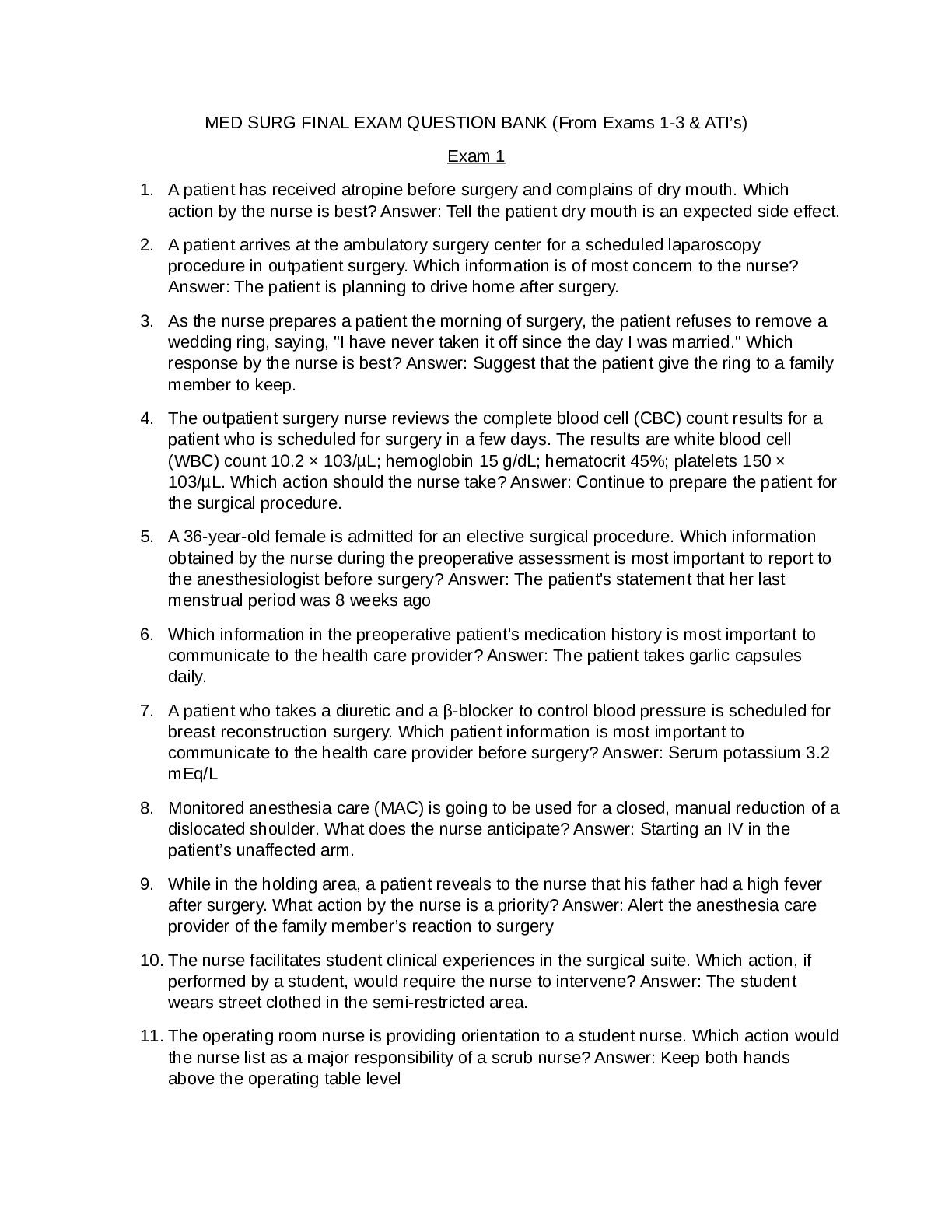
Reviews( 1 )

by Carmela Caravello · 2 years ago
not sure yet
Recommended For You
*NURSING> EXAM > NSG5002 FINAL EXAM QUESTIONS & ANSWERS,100% CORRECT (All)

NSG5002 FINAL EXAM QUESTIONS & ANSWERS,100% CORRECT
As patients that entrust our care to another individual, we always expect honesty to avoid leading us down a deceptive pathway in our healthcare decisions. Adherence to which principle compels provide...
By securegrades , Uploaded: Oct 27, 2020
$13
*NURSING> EXAM > NURS 6501 / NURS6501, Advanced Pathophysiology Final exam | Week 11| Already Graded A | LATEST 2020 / 2021 (All)
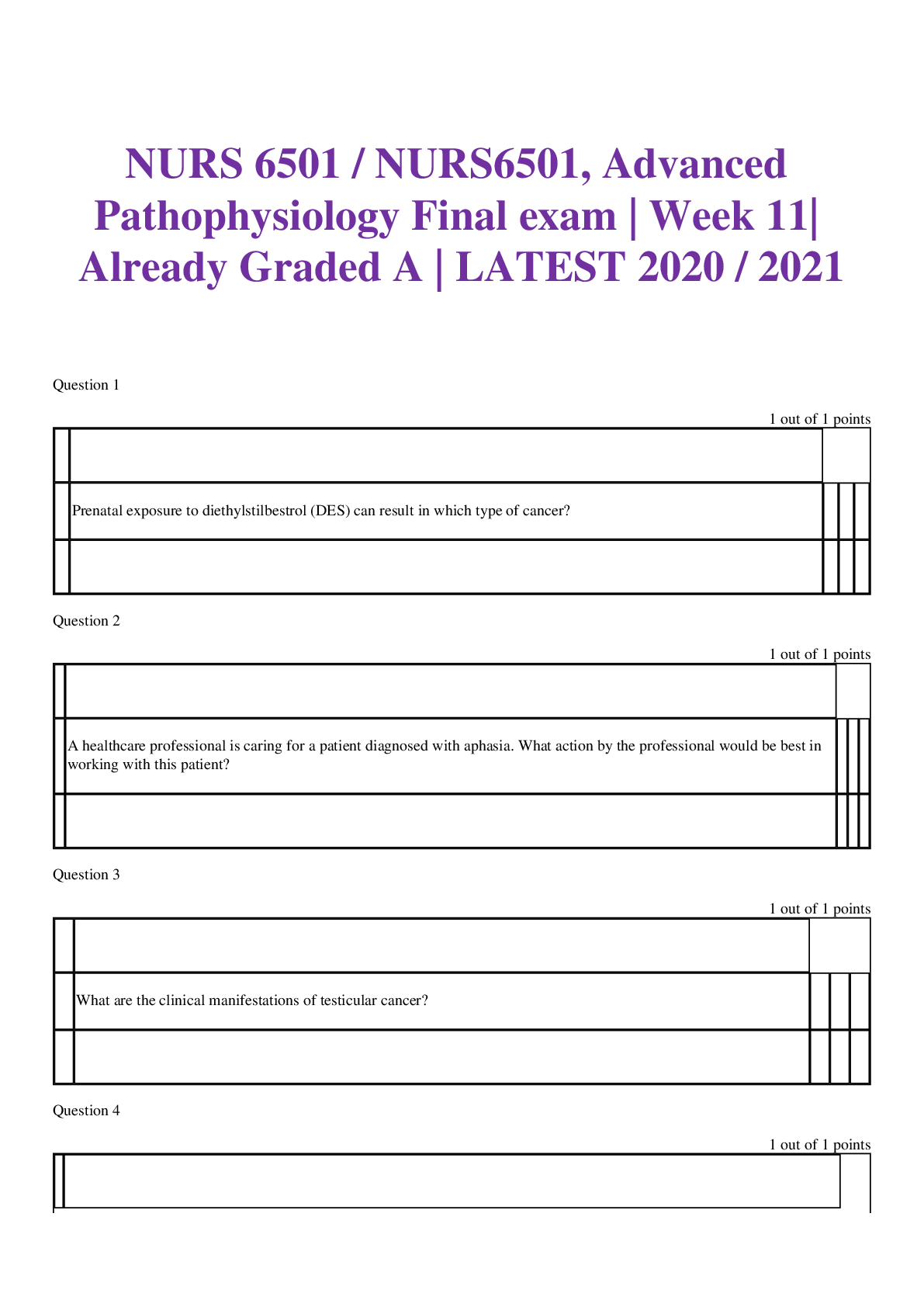
NURS 6501 / NURS6501, Advanced Pathophysiology Final exam | Week 11| Already Graded A | LATEST 2020 / 2021
NURS 6501 / NURS6501, Advanced Pathophysiology Final exam | Week 11| Already Graded A | LATEST 2020 / 2021 • Question 1 1 out of 1 points Prenatal exposure to diethylstilbestrol (DES) can r...
By nurse_steph , Uploaded: Dec 06, 2020
$10
*NURSING> EXAM > NURS 6501 / NURS6501, Advanced Pathophysiology Final exam | Week 11 | LATEST 2020 / 2021 | Already Graded A (All)
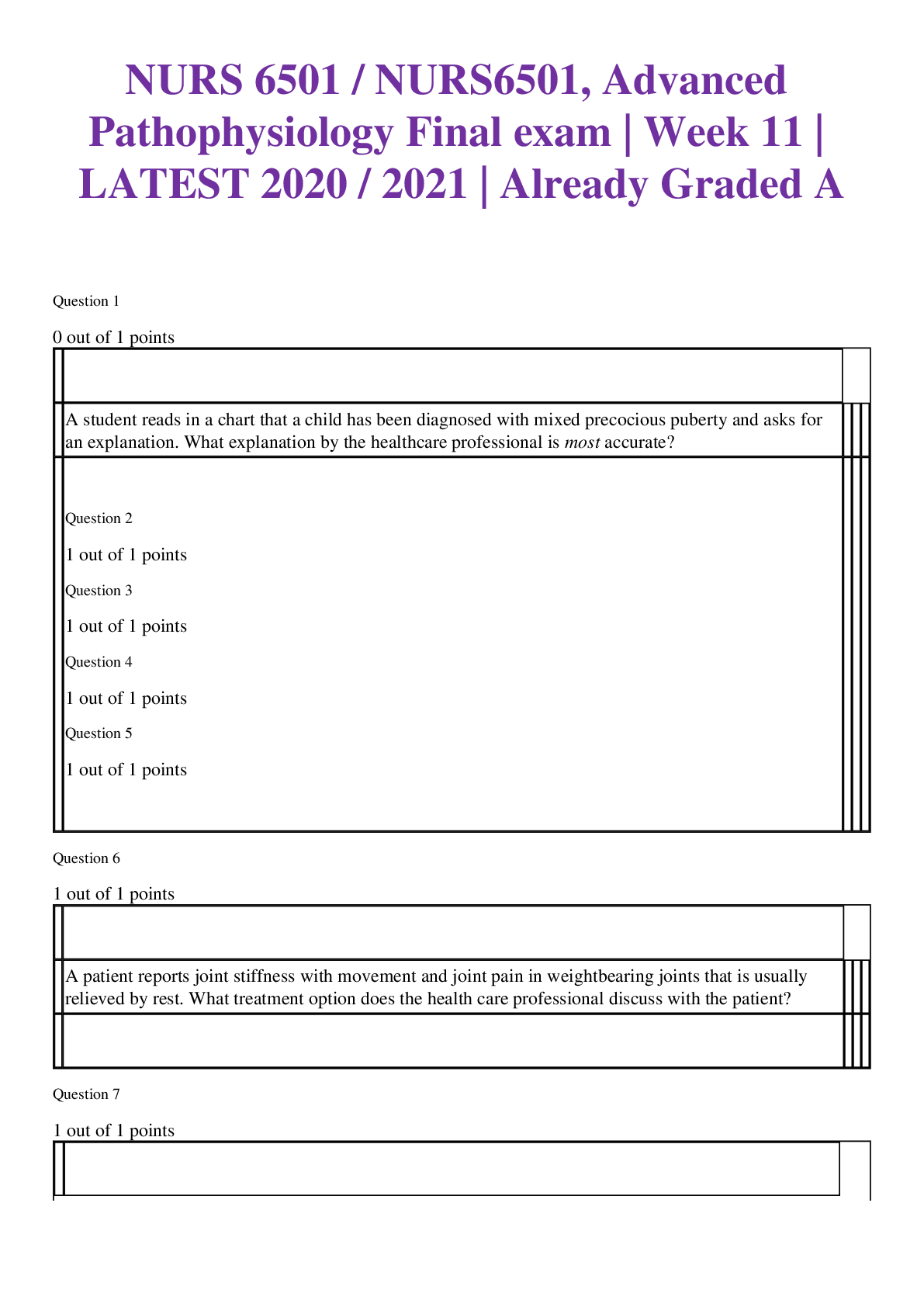
NURS 6501 / NURS6501, Advanced Pathophysiology Final exam | Week 11 | LATEST 2020 / 2021 | Already Graded A
NURS 6501 / NURS6501, Advanced Pathophysiology Final exam | Week 11 | LATEST 2020 / 2021 | Already Graded A • Question 1 0 out of 1 points A student reads in a chart that a child has been d...
By nurse_steph , Uploaded: Dec 06, 2020
$10
*NURSING> EXAM > NURS 6501 / NURS6501, Advanced Pathophysiology Final exam | Week 11 | Already Graded A | LATEST 2020 / 2021 (All)

NURS 6501 / NURS6501, Advanced Pathophysiology Final exam | Week 11 | Already Graded A | LATEST 2020 / 2021
NURS 6501 / NURS6501, Advanced Pathophysiology Final exam | Week 11 | Already Graded A | LATEST 2020 / 2021 • Question 1 1 out of 1 points Which statement by the healthcare professional...
By nurse_steph , Uploaded: Dec 06, 2020
$10
*NURSING> EXAM > NUR 2214 / NUR2214 Nursing Care of the Older Adult Quiz 4 | Questions and Answers | Already Graded A | Rasmussen College (All)
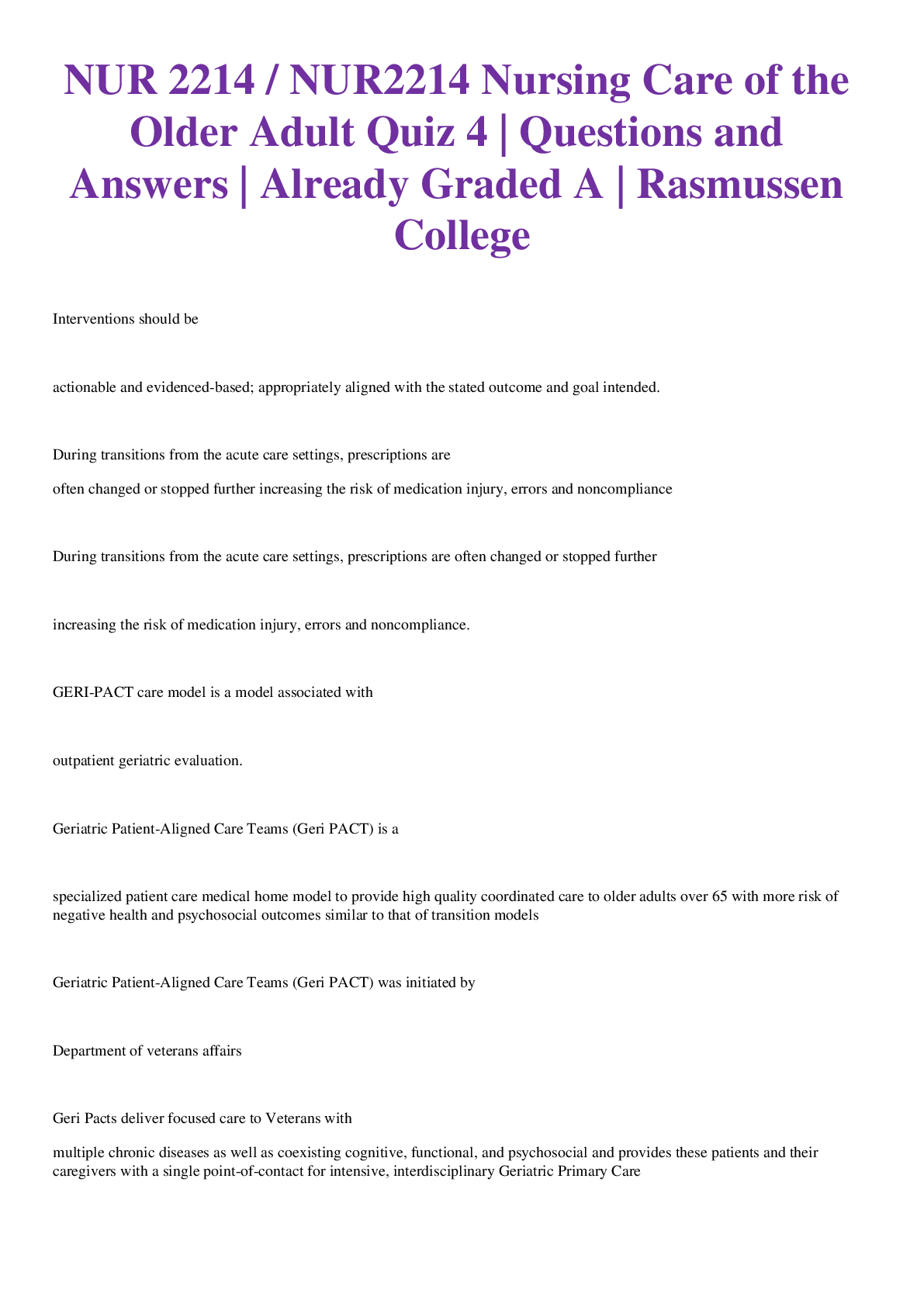
NUR 2214 / NUR2214 Nursing Care of the Older Adult Quiz 4 | Questions and Answers | Already Graded A | Rasmussen College
NUR 2214 / NUR2214 Nursing Care of the Older Adult Quiz 4 | Questions and Answers | Already Graded A | Rasmussen College 1. Interventions should be - actionable and evidenced-based; appropriate...
By nurse_steph , Uploaded: Dec 07, 2020
$9
*NURSING> EXAM > NURS-6512N / NURS 6512 / NURS6512, Advanced Health Assessment Midterm Exam | Already Graded A | LATEST 2020 / 2021 (All)
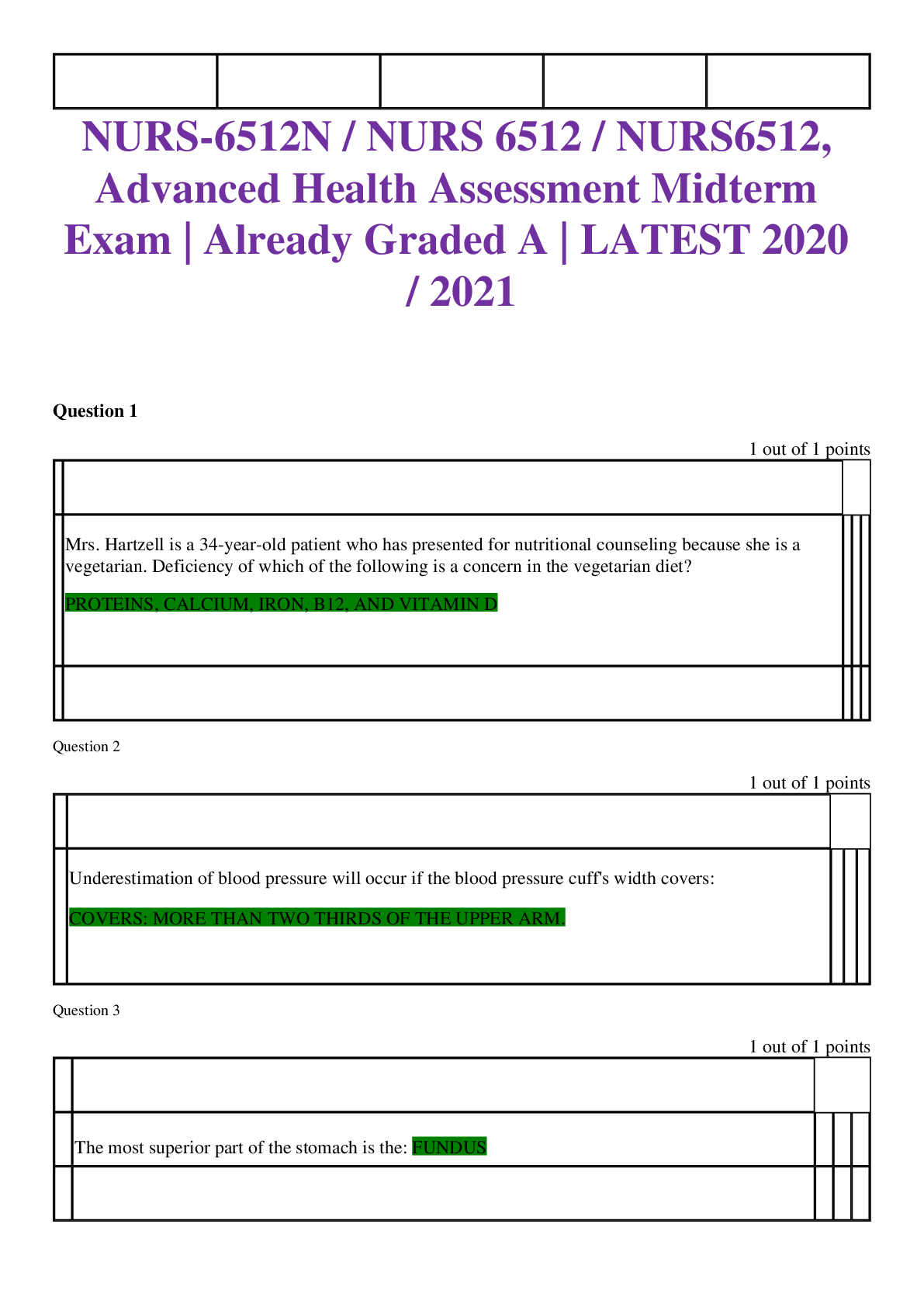
NURS-6512N / NURS 6512 / NURS6512, Advanced Health Assessment Midterm Exam | Already Graded A | LATEST 2020 / 2021
NURS-6512N / NURS 6512 / NURS6512, Advanced Health Assessment Midterm Exam | Already Graded A | LATEST 2020 / 2021 Question 1 1 out of 1 points Mrs. Hartzell is a 34-year-old patient who ha...
By nurse_steph , Uploaded: Dec 09, 2020
$10
*NURSING> EXAM > NURS-6512N / NURS 6512 / NURS6512, Advanced Health Assessment Midterm Exam | LATEST 2020 / 2021 | Already Graded A (All)
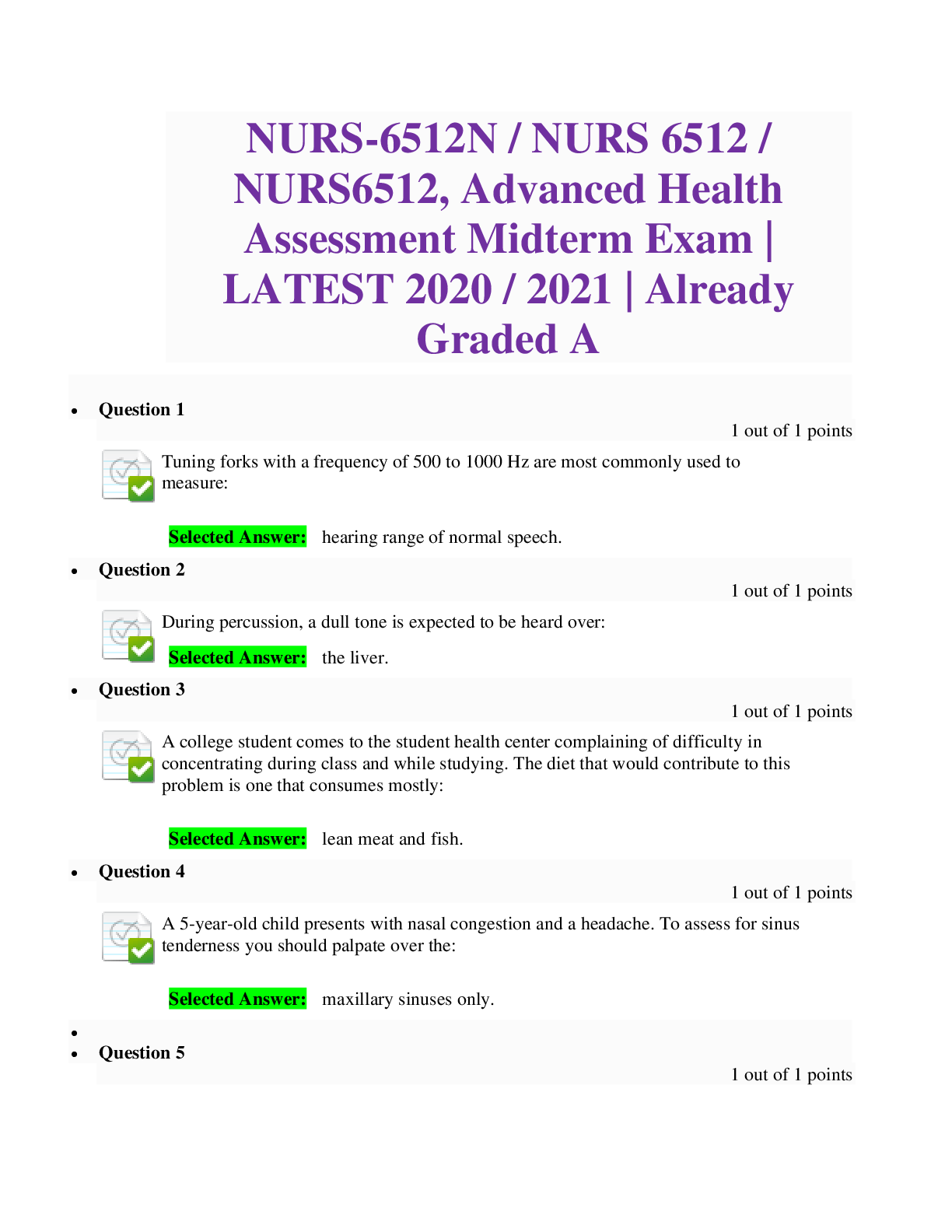
NURS-6512N / NURS 6512 / NURS6512, Advanced Health Assessment Midterm Exam | LATEST 2020 / 2021 | Already Graded A
NURS-6512N / NURS 6512 / NURS6512, Advanced Health Assessment Midterm Exam | LATEST 2020 / 2021 | Already Graded A • Question 1 1 out of 1 points Tuning forks with a frequency of 500 to 100...
By nurse_steph , Uploaded: Dec 09, 2020
$10
*NURSING> EXAM > NR 507 / NR507 Advanced Pharmacology Final Exam | Questions and Answers with Rationale | Already Graded A | Complete Solutions| Latest 2020 / 2021 | Chamberlain College (All)
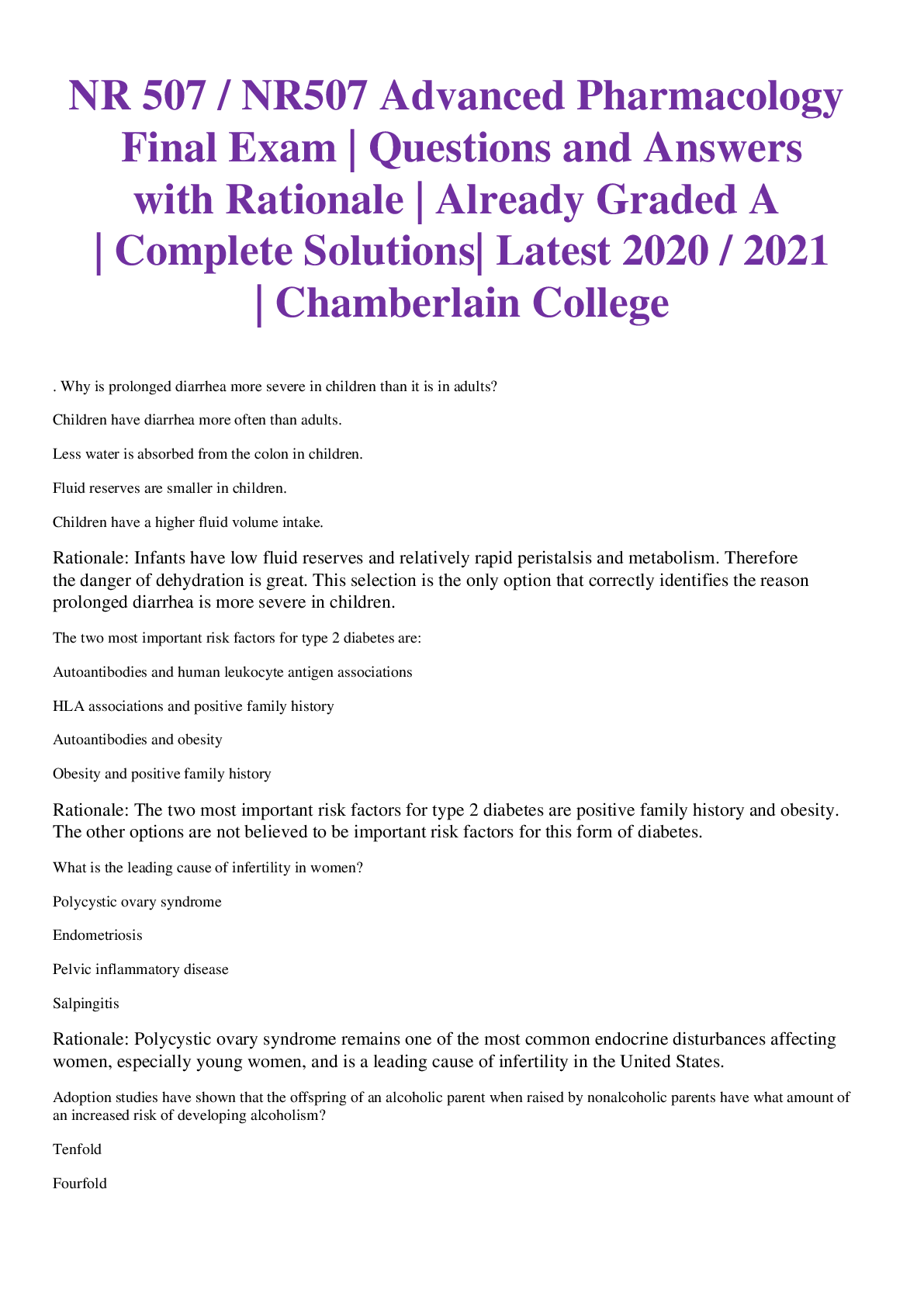
NR 507 / NR507 Advanced Pharmacology Final Exam | Questions and Answers with Rationale | Already Graded A | Complete Solutions| Latest 2020 / 2021 | Chamberlain College
NR 507 / NR507 Advanced Pharmacology Final Exam | Questions and Answers with Rationale | Already Graded A | Complete Solutions| Latest 2020 / 2021 | Chamberlain College 1. . Why is prolonged diarrh...
By nurse_steph , Uploaded: Dec 18, 2020
$14
*NURSING> EXAM > Pharmacology Final Exam Questions and answers (All)
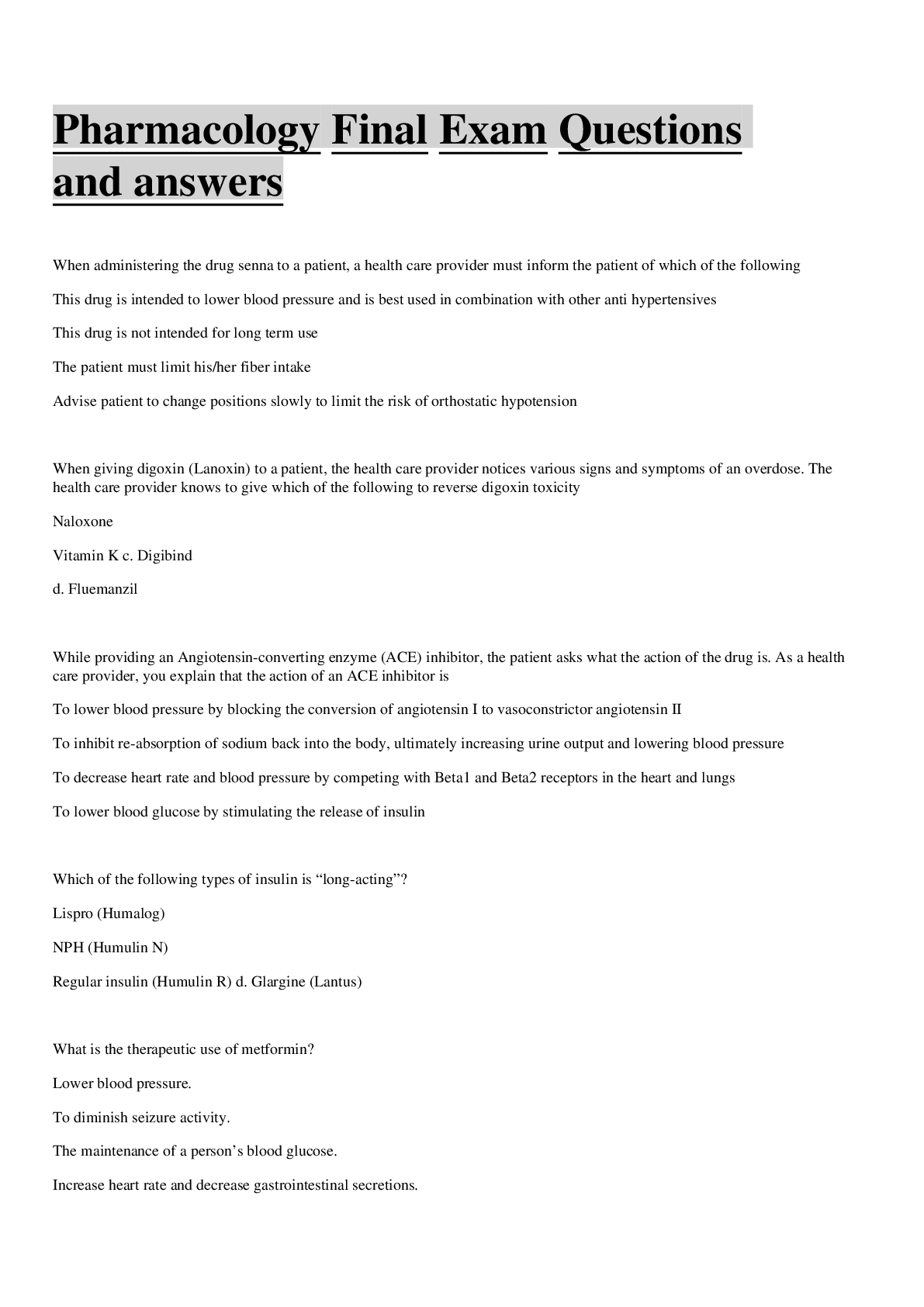
Pharmacology Final Exam Questions and answers
Pharmacology Final Exam Questions and answers 1. When administering the drug senna to a patient, a health care provider must inform the patient of which of the following a. This drug is intended...
By tutorcwakuthii , Uploaded: Aug 23, 2023
$14
NRNP 6552 Women's health final exam> EXAM > NRNP 6552 Women's health final exam questions and answers (Walden University) (All)
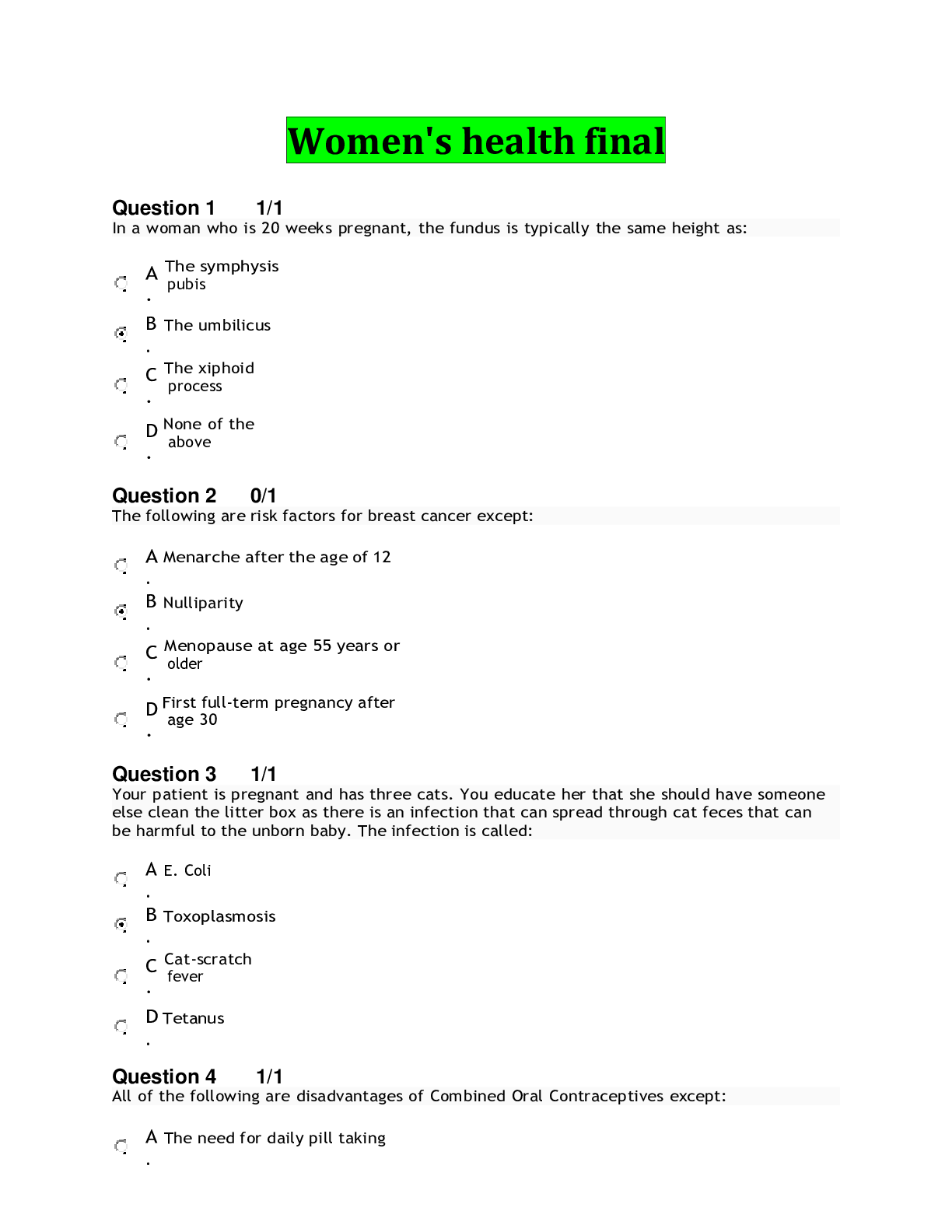
NRNP 6552 Women's health final exam questions and answers (Walden University)
NRNP 6552 Women's health final exam questions and answers (Walden University) Question 1 1/1 A The symphysis . pubis B The umbilicus . C The xiphoid . process D None of the . above...
By NurseMentor , Uploaded: Jun 06, 2023
$8
Document information
Connected school, study & course
About the document
Uploaded On
Apr 27, 2021
Number of pages
16
Written in
Additional information
This document has been written for:
Uploaded
Apr 27, 2021
Downloads
1
Views
64





